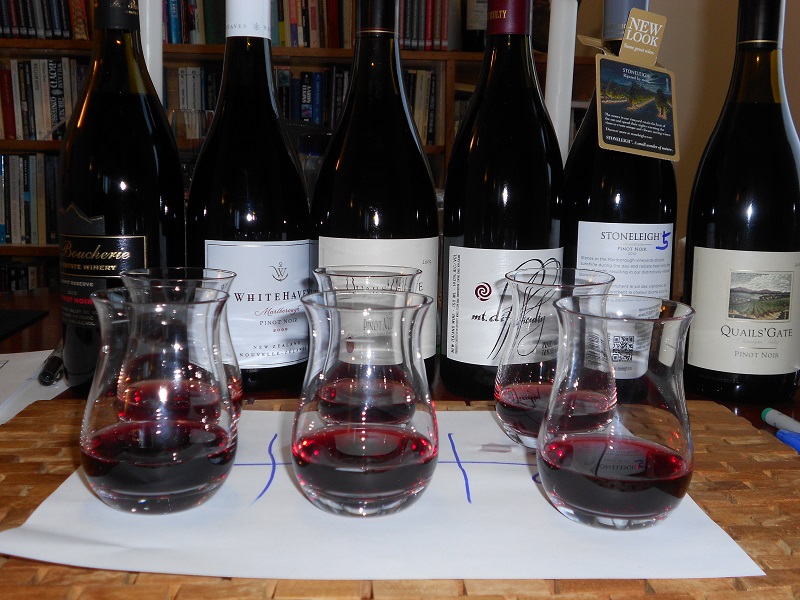In case you had to spend time in a religious retreat or something, pinot noir is now everywhere. This is generally good, but there is PN on the market that is about the absolute opposite of the elegant wines of Burgundy. I had a Californian the other week that collapsed into cough syrup in eight hours. Iíve never seen a red wine surrender all integrity that quickly.
The biggest single issue in the PN market is pricing. The combination of justification (from the movie Sideways among other places) and the rising prices of status Burgundies has caused PN to be priced about 30 per cent or more than a comparable quality cabernet sauvignon.
[related_content slugs=”merlot-the-good-the-bad-and-the-ugly,time-to-start-drinking-california-chardonnays-again,fine-pleasures” description=”More from James Romanow” position=”right”]
For my money, the two and a half places to really pursue PN are Oregon and New Zealand; the half place is Canada, where I’ve had some good PN, but pricing is all over the map. Burgundy is another great hunting ground, assuming you have a LOT of money. Decent burgundies start around $50 these days, and frankly I’m happier with a $30 Kiwi product.
The Californian product is an interesting drink – I’m not even sure it qualifies as wine any more – but they are making a product that is thick and completely different from what I think of as the varietal traits.
This of course is the pinot noir problem of the moment. For any other wine, above about $25 the wine world is your oyster. The only real question is which wine over that price point do you care to unbelt for. For Pinot Noir you have to add another 12 bucks.
New Zealand PN is similar to their sauvignon blanc: It is both representative and a slightly new take on a very old grape. In contrast to their sometimes overly exuberant sauvignon blanc, their pinot tends to a subtlety and purity of flavour I associate with organic wines. Itís light, less dusty than a Burgundy or Canadian version, and makes a wonderful companion all evening long. Not that they aren’t capable of some kind of grape jelly similar to the Californian product, but for the most part they seem to like their reds fairly lean.
The main PN growing areas in New Zealand are Marlborough and Otago. The Kiwis believe, with good reason that Otago makes the best pinot noir of the three. Itís climate is cooler, and the chance of failure higher.
Marlborough cultivates quite a bit of pinot noir, and although the Kiwis argue about it, the stuff is first rate. Best of all, Marlboroughís success with sauvignon blanc make their PN more common in N. America.
Stoneleigh is a surprisingly mineral wine with a slightly metallic edge to it. More angular than most wines at this price point, it is a wine for drinkers with a slightly refined palate. If youíre looking for an unctuous vanilla coated wine, this one will disappoint. On the other hand if you like a bit of backbone, this is a great deal, and the cheapest wine listed here.
Whitehaven is the Marlborough pinot noir, and try though I might I canít say I could identify a distinctive difference between Otago and Marlborough. Possibly a wider tasting on the South island would let me work it out, but Iím not entirely convinced. The bouquet is licorice and strawberry. The palate was a little more obvious, which makes the wine very approachable. It turned out to be Saireyís pick of the lot.
Wild South makes a tremendously food friendly pinot noir, and that’s saying a lot. There are few better all round wines than pinot noir. It goes with steak, it goes with lamb, it even goes with chicken adobo.
Wild South is wine I find myself returning to constantly. At first it was too distinctive from the Burgundian style for me to understand; but there was something there, a core of flavour that kept me coming back.
Wild South has clean fruit and a slightly smoky finish that reminds me of September, of burning leaves, a faint nostalgia for summer past.
A wine more in line with what people drink from California is the Torlese Pinot Noir from Waipara. I don’t think Waipara qualifies as truly Otego, but my geography of this part of the South Island is a little vague. It’s south of Martinsville, and in any event their wine is thick, and fruity. It’s a nice flavour set, but if you’re looking for something more refined you need to pay more money.
You needn’t stick with my pick however. There are a zillion available at different stores across the prairies. Set up an Otago vs. Marlborough dinner party and find the one you like.
Devilís Staircase Pinot Noir, Central Otago, New Zealand, 2008. $41.52 *****
Mt. Difficulty Pinot Noir, New Zealand, 2010. $39 *****
Wild South Pinot Noir, Marlborough New Zealand, 2008. $26 *****
Oyster Bay Pinot Noir, Marlborough, New Zealand, 2008. $24 ****
Rockburn Pinot Noir, Central Otago, New Zealand, 2008. $24 ****
Stoneleigh Pinot Noir, New Zealand, 2010. $21.95 ****
Whitehaven Pinot Noir, New Zealand, 2009. $24.99 ****
Torlese Pinot Noir, Waipara New Zealand, 2010. ****
___
James Romanow writes about Wine and all things Boozy for the Spectator Tribune. Follow him @drbooze
Follow us: @SpectatorTrib
